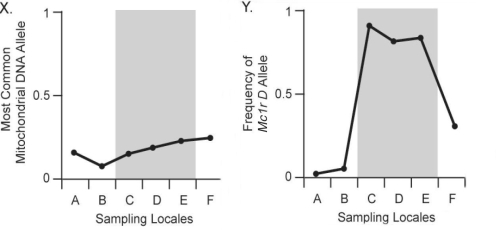Multiple Choice
Figure 24.2

-The distribution of pocket-mouse coat colors in several Arizona populations is associated with substrate color.Some populations live on light-colored granite substrate,and others live on dark volcanic rock.In Figure 24.2,chart A shows the frequency of the melanic (dark) coat phenotype across six populations.Populations C,D,and E live on dark volcanic rock;populations A,B,and F live on light-colored granite.Chart B shows the frequency of the Melanocortin-1 receptor (Mc1r) allele across these populations.The Mc1r alleles,D and d,differ by four amino acids;mice with DD and Dd genotypes have dark coats,whereas mice with dd genotype are light colored.Which of the following statements best interprets the results shown in charts A and B?
A) Frequency of the D allele is closely associated with the melanic phenotype,but is unrelated to the presence of dark substrate color.
B) Frequency of the D allele is not associated with the melanic phenotype,but is associated with the presence of dark substrate color.
C) Frequency of the D allele is closely associated with both the melanic phenotype and the presence of dark substrate color.
D) Frequency of the D allele is associated neither with the melanic phenotype nor with the presence of dark substrate color.
E) Frequency of the D allele does not vary.
Correct Answer:

Verified
Correct Answer:
Verified
Q7: The same basic internal organs (kidneys, stomach,
Q22: Which of the following is a fitness
Q23: Your text discusses the evolution of antibiotic-resistant
Q25: Use the following information when answering the
Q26: If two organisms show a developmental homology,you
Q27: Cotton-topped tamarins are small primates with tufts
Q28: Which of the following situations could not
Q29: Figure 24.1<br>The following question(s)are based on information
Q30: Parasitic species tend to have simple morphologies.Which
Q32: Explain how one of the following supports